- Joined
- Feb 2, 2011
- Messages
- 2,093
NEW RELEASES FOR OCTOBER 2022
THE FUR TRADE
MOUNTAIN MEN – THE RENDEZVOUS
A mountain man was an explorer who lived in the wilderness. They were instrumental in opening up the various Emigrant Trails (widened into wagon roads) allowing Americans in the east to settle the new territories of the far west by organized wagon trains traveling over roads explored and in many cases, physically improved by the mountain men and the big fur companies originally to serve the mule train based inland fur trade.
Mountain men were most common in the North American Rocky Mountains from about 1810 through to the 1880s (with a peak population in the early 1840s). Approximately 3,000 mountain men ranged the mountains between 1820 and 1840, the peak beaver-harvesting period. While there were many free trappers, most mountain men were employed by major fur companies. The life of a company man was almost militarized. The men had mess groups, hunted and trapped in brigades and always reported to the head of the trapping party.
This man was called a "boosway", a bastardization of the French term bourgeois. He was the leader of the brigade and the head trader.
The Mountain men represents the “Beaver Pelts” of the original WSP title, and is the smallest part of the series, as it mainly concentrates on the individual men and personalities that worked alone or in pairs in the mountain wilderness.
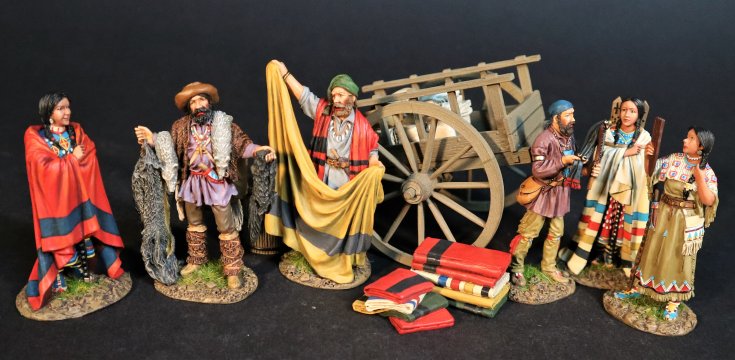
The Rendezvous was an annual gathering, at various locations held by a fur trading company at which trappers and mountain men sold their furs and hides and replenished their supplies.
The large fur companies put together teamster driven mule trains which packed in whiskey and supplies into a pre-announced location each spring/summer and set up a trading fair- the Rendezvous.
These Rendezvous were known to be lively, joyous places, where all were welcome, fur trappers, Indians, native trapper wives, and children, travellers and later on even tourists who would venture from as far as Europe to observe the festivities.
They were described as events “full of myrth, songs, dancing, shouting, trading, running, singing, racing, target-shooting, yarns, frolics, with all sorts of extravagances that white men or Indians could invent!”
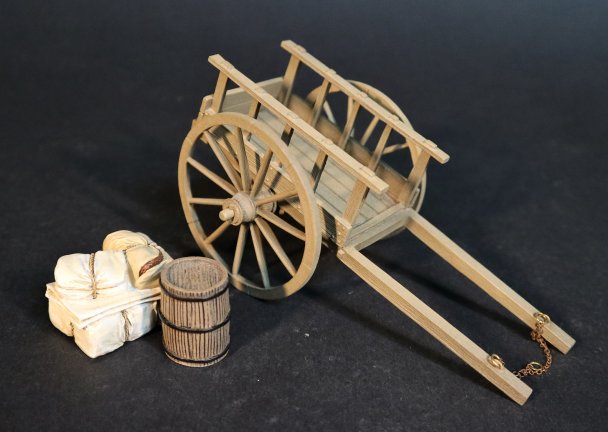
WSP-103
THE FUR TRADE,
THE RED RIVER CART
(5 pcs)
The Red River cart was a large two-wheeled cart made entirely of non-metallic materials. These carts were often drawn by oxen, although also by horses or mules. The carts were used throughout most of the nineteenth century in the fur trade and in westward expansion in Canada and the United States, in the area of the Red river and on the plains west of the Red River Colony.
The cart was a simple conveyance developed by the Metis for use in their settlement on the Red River in what later became Manitoba. With these carts, the Metis were not restricted to river travel to hunt bison.
The Red River cart was largely responsible for commercializing the buffalo hunt.
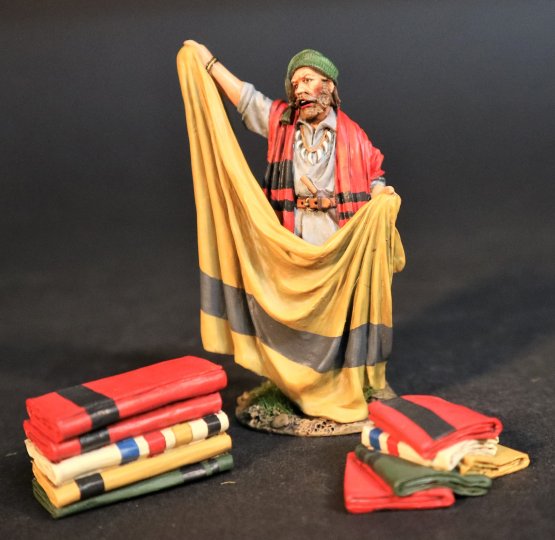
WSP-56
THE FUR TRADE,
THE ROCKY MOUNTAIN RENDEZVOUS,
THE BLANKET SALESMAN.
(3 pcs)
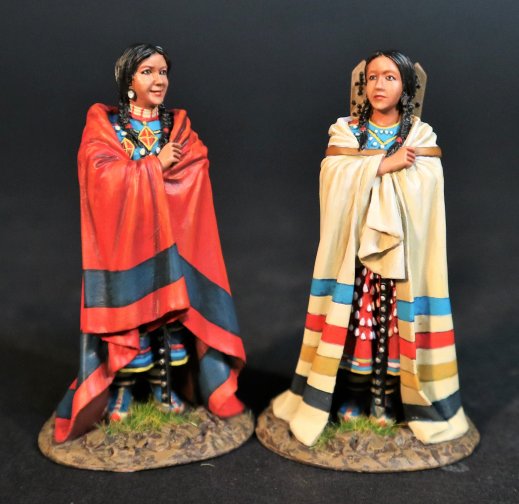
WSP-57
THE FUR TRADE,
THE ROCKY MOUNTAIN RENDEZVOUS,
2 SQUAWS.
(2 pcs)
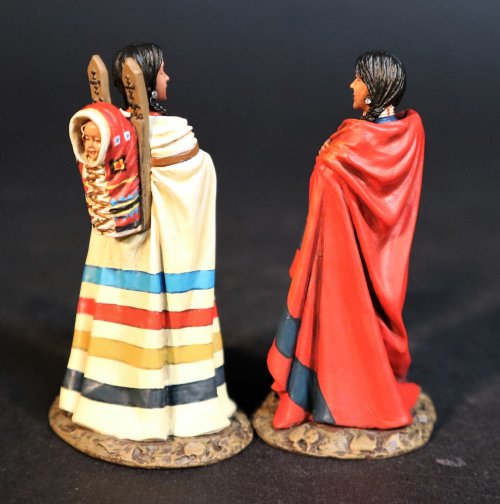
OXEN FOR 18[SUP]th[/SUP] AND 19[SUP]th[/SUP] CENTURY COLLECTIONS
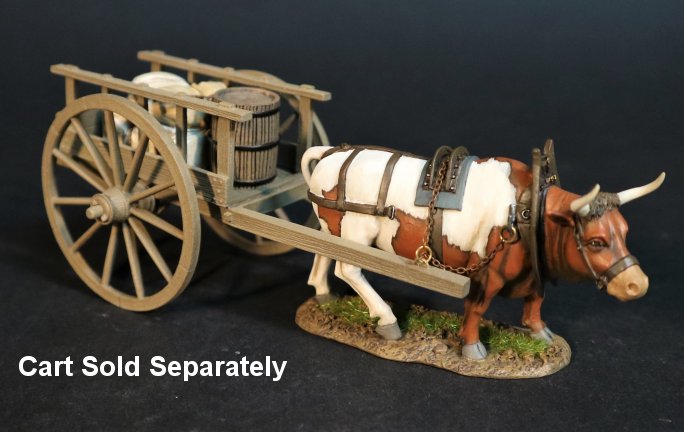
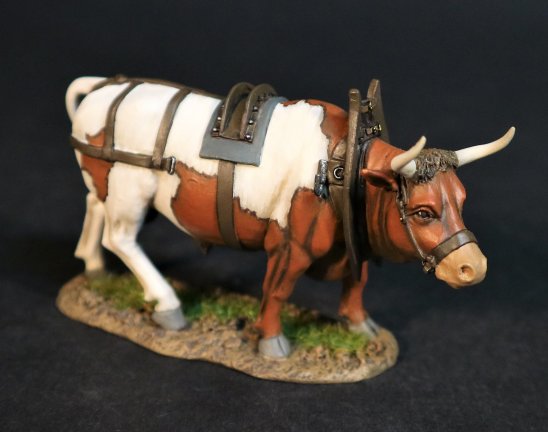
WSP-104
THE FUR TRADE,
OX.
(1 pc)
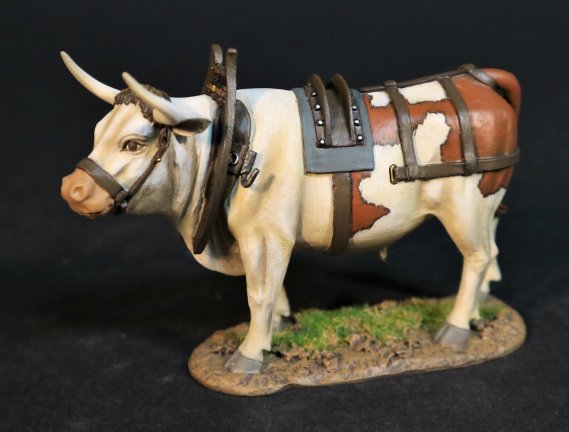
WSP-105
THE FUR TRADE,
OX.
(1 pc)
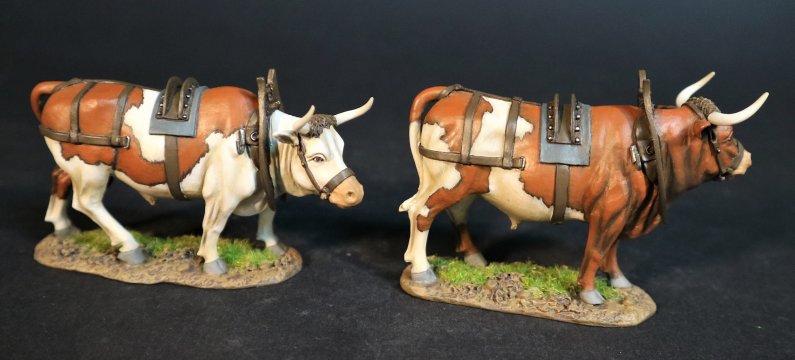
WSP-106
THE FUR TRADE,
OXEN.
(2 pcs)
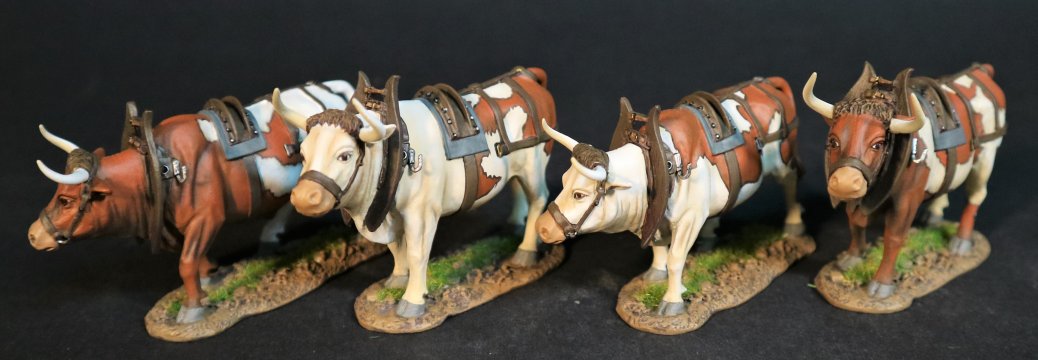
WSP-107
THE FUR TRADE,
OXEN.
(4 pcs)
PLEASE NOTE THE OXEN WILL FIT ALL THE JJD WAGONS AND CARTS.
THERE WOULD HAVE BEEN PICTURES OF THE OXEN WITH THE CARTS, LIMBER AND CONNESTOGA WAGON, BUT THESE 3 ITEMS ARE NOW AT THE FACTORY AS THEY WILL BE RE- RELEASED NEXT YEAR.
PLEASE CONTACT YOUR LOCAL DEALER FOR FURTHER INFORMATION
THE FUR TRADE
MOUNTAIN MEN – THE RENDEZVOUS
A mountain man was an explorer who lived in the wilderness. They were instrumental in opening up the various Emigrant Trails (widened into wagon roads) allowing Americans in the east to settle the new territories of the far west by organized wagon trains traveling over roads explored and in many cases, physically improved by the mountain men and the big fur companies originally to serve the mule train based inland fur trade.
Mountain men were most common in the North American Rocky Mountains from about 1810 through to the 1880s (with a peak population in the early 1840s). Approximately 3,000 mountain men ranged the mountains between 1820 and 1840, the peak beaver-harvesting period. While there were many free trappers, most mountain men were employed by major fur companies. The life of a company man was almost militarized. The men had mess groups, hunted and trapped in brigades and always reported to the head of the trapping party.
This man was called a "boosway", a bastardization of the French term bourgeois. He was the leader of the brigade and the head trader.
The Mountain men represents the “Beaver Pelts” of the original WSP title, and is the smallest part of the series, as it mainly concentrates on the individual men and personalities that worked alone or in pairs in the mountain wilderness.

The Rendezvous was an annual gathering, at various locations held by a fur trading company at which trappers and mountain men sold their furs and hides and replenished their supplies.
The large fur companies put together teamster driven mule trains which packed in whiskey and supplies into a pre-announced location each spring/summer and set up a trading fair- the Rendezvous.
These Rendezvous were known to be lively, joyous places, where all were welcome, fur trappers, Indians, native trapper wives, and children, travellers and later on even tourists who would venture from as far as Europe to observe the festivities.
They were described as events “full of myrth, songs, dancing, shouting, trading, running, singing, racing, target-shooting, yarns, frolics, with all sorts of extravagances that white men or Indians could invent!”

WSP-103
THE FUR TRADE,
THE RED RIVER CART
(5 pcs)
The Red River cart was a large two-wheeled cart made entirely of non-metallic materials. These carts were often drawn by oxen, although also by horses or mules. The carts were used throughout most of the nineteenth century in the fur trade and in westward expansion in Canada and the United States, in the area of the Red river and on the plains west of the Red River Colony.
The cart was a simple conveyance developed by the Metis for use in their settlement on the Red River in what later became Manitoba. With these carts, the Metis were not restricted to river travel to hunt bison.
The Red River cart was largely responsible for commercializing the buffalo hunt.

WSP-56
THE FUR TRADE,
THE ROCKY MOUNTAIN RENDEZVOUS,
THE BLANKET SALESMAN.
(3 pcs)

WSP-57
THE FUR TRADE,
THE ROCKY MOUNTAIN RENDEZVOUS,
2 SQUAWS.
(2 pcs)

OXEN FOR 18[SUP]th[/SUP] AND 19[SUP]th[/SUP] CENTURY COLLECTIONS


WSP-104
THE FUR TRADE,
OX.
(1 pc)

WSP-105
THE FUR TRADE,
OX.
(1 pc)

WSP-106
THE FUR TRADE,
OXEN.
(2 pcs)

WSP-107
THE FUR TRADE,
OXEN.
(4 pcs)
PLEASE NOTE THE OXEN WILL FIT ALL THE JJD WAGONS AND CARTS.
THERE WOULD HAVE BEEN PICTURES OF THE OXEN WITH THE CARTS, LIMBER AND CONNESTOGA WAGON, BUT THESE 3 ITEMS ARE NOW AT THE FACTORY AS THEY WILL BE RE- RELEASED NEXT YEAR.
PLEASE CONTACT YOUR LOCAL DEALER FOR FURTHER INFORMATION

